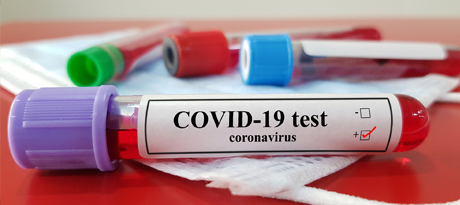
sittithat tangwitthayaphum / istock
Serology tests that detect SARS-CoV-2 virus antibodies (immunoglobulin A/G/M) have proliferated as society looks for ways to relax quarantine restrictions. Such tests might help track community spread of SARS-CoV-2 virus and determine whether plasma donated by patients who have recovered from COVID-19, the illness caused by SARS-CoV-2, could help still sick patients recover.
The U.S. Food and Drug Administration (FDA) in March allowed serology tests to come to market without an Emergency Use Authorization (EUA) if a test had been validated, the FDA was notified, and the developer included statements with the test that it had not been reviewed by the FDA and the test results should not the sole basis for diagnosing or excluding SARS-CoV-2 infection or to inform infection status. FDA on May 4 updated its EUA policies for COVID-19 antibody tests, requiring developers to submit their EUA requests, along with their validation data, within 10 business days. FDA also set performance characteristics for approved tests, including 90% sensitivity and 95% specificity. At the time of this policy change, more than 100 SARS-CoV-2 antibody tests had made it to market in the U.S., some of dubious quality.
Meanwhile, organizations such as the World Health Organization (WHO) and the Royal College of Pathologists of Australasia have expressed concerns about COVID-19 antibody tests.
Because of the challenges with and limitations of SARS-CoV-2 serology tests, labs across the country are considering many variables in choosing and implementing these tests.
Yashpal Agrawal, MD, PhD, section chief of chemistry, toxicology, and point-of-care at the Rocky Mountain Regional VA Medical Center in Aurora, Colorado, sees FDA’s EUA as a key starting point. Without an EUA, the validation of the test as a laboratory developed test (LDT) becomes more demanding, Agrawal told CLN Stat. Considering the general lack of validation materials and infection risks, “I would avoid validating these serologic tests as an LDT,” he added.
Ensuring that serology tests can differentiate SARS-CoV-2 from both SARS (CoV-1) and other less virulent coronaviruses that are or have been in circulation is of great importance, agreed Elizabeth Rayburn, PhD, DABT, NRCC. As a lab director who oversees several CLIA labs, Rayburn is also concerned about the tests’ sensitivity and specificity. “It’s currently unclear how low the antibody titers are in recovered patients. The reports so far have shown a pretty wide range, but whether that’s due to the different assays used, the timing of the sample collection, or other factors is unclear,” Rayburn said.
Labs must also consider what type of test kit they should use. Agrawal said he would divide the tests into three groups: enzyme-linked immunosorbent assays (ELISA), lateral flow immunoassays, and large chemistry analyzer-based tests. The California COVID-19 Testing Task Force recently published evaluation criteria for COVID-19 serology screening—both rapid disposable serology tests and ELISA. TriCore Reference Laboratories in Albuquerque also developed a technical bulletin about serology testing for SARS-CoV-2 antibodies.
With an ELISA test, it is critical that a lab’s analyzer is able to run the vendor’s test. “The one ELISA analyzer that we have does not meet the manufacturer’s incubation temperature requirements (37± 1C), and can only meet the looser (37± 2C) specification. So whether your analyzer is able to meet the test specifications needs to be carefully looked at,” he advised. Otherwise a lab might have to buy an ELISA analyzer from the vendor, which could run between $65,000 and $100,000. This causes delays, “since you have to purchase the instrument, establish electronic interfaces, etc.,” Agrawal said. However, ELISA tests have advantages: high throughput, electronic interfaces, and producing quantitative IgG/IgM levels, which could prove useful in determining patients’ immunity to SARS-CoV-2.
The big limitation with lateral flow immunoassays is lack of access. “Only one assay has been approved, and the company does not appear to have any tests available for purchase,” Agrawal said. The test itself has some disadvantages, such as a lack of electronic interface. This may be problematic if testing volumes are expected to be high. And, because these tests are qualitative, a quantitative estimate of the IgG/IgM level would not be available.
Most clinical labs may end up choosing tests that run on large chemistry analyzers, due to their high throughput, electronic interface, and experience with performance of test validations. “These assays are likely to be semi-quantitative in nature, though we have yet to see what tests the vendors will release,” Agrawal said.
Once better commercial tests become available, Agrawal expects that decisions over choice will largely depend on performance characteristics, how labor-intensive the assay is, how long the assay takes to run, the platform being used, and the cost and availability of the reagents. At least at his lab, developing a SARS-CoV-2 assay is not an option. “We can only purchase a test that has an EUA or if pressed, treat the test validation as for a LDT,” he said.
Rayburn said her team is developing an LDT, mainly because no commercial test has shown sufficient accuracy, specificity, and sensitivity. “Being able to have some leeway for reagents is a plus given the supply problems that have plagued a lot of the commercial assays. Since we’re developing the assay in-house, we can build in extra validation steps to check different suppliers/reagents to make sure we’ll be able to test consistently once we go live,” she said.
For clinical labs seeking information on serology tests, the AACC Artery’s SARS-CoV-2 Testing forum is open to all interested parties. Non-AACC members are asked to complete a brief, free registration process to join this forum.